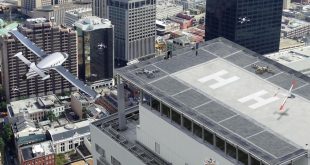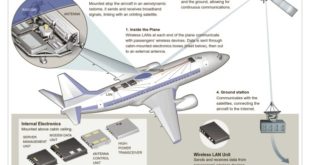Air Force has released a rendering of what appears to be its vision for concept under the Low Cost Attritable Aicraft Technology (LCAAT) banner. The Low Cost Attritable Aircraft Technology (LCAAT) Initiative is aimed at developing a low cost attritable aircraft design and manufacturing concept costing less than $3M (without mission systems). The goal is to develop and demonstrate low cost design and manufacturing technologies, then validate concepts with a campaign of flight demonstrations.
Chinese military has been engaged in comprehensive modernization of its air, naval, and ground forces, while incorporating a variety of anti-access/area denial (A2/AD) systems and capabilities. “To operate against adversaries with “anti-access / area denial” capabilities the U.S. needs to disperse its forces, disaggregate its capabilities, confuse enemy sensors through decoys and deception, and swarm enemy defenses with large numbers of expendable assets,” says Paul Scharre, Senior Fellow and Director 20YY Future of Warfare.
Future anticipated military threats and tighter defense budgets combine to drive the need for new and innovative solutions towards the development of future low cost unmanned aerospace systems (UAS). As aircraft cost has continued to escalate, the Air Force is interested in UAS concepts that offer dramatic reductions in cost in order to bring “mass” to the engagement, and to achieve a cost imposing effect on future adversaries, says AFRL.
UAS performance, design life/reliability, and maintainability drive the cost of today’s systems, and need to be traded to achieve the optimum capability/cost effects. This effort is directed at the development of an attritable aircraft concept where by virtue of its cost, loss of aircraft could be tolerated. However these aircraft would be intended for reuse with limited life/sorties. Considering the tempo of the engagement and phase of war, the level of attritability that would be tolerated could change with operations as they advance with time.
This low cost attritable aircraft technology (LCAAT) concept will provide long range, transonic, strike capability in remote/ contested regions where forward basing is difficult or prohibited.” “The USAF requires the ability to find, fix, track, and prosecute targets in contested and denied environments, and to provide these capabilities at long range where forward basing is not viable. A long range high performance unmanned attritable aircraft to conduct strike and/or ISR missions would provide a “game changing” capability,” writes Bill Baron is a Principal Aerospace Engineer in the Aerospace Vehicles Division, Aerospace Systems Directorate, Air Force Research Laboratory (AFRL/RQV).
Low-Cost Attritable Strike Unmanned Aerial System
The Air Force is studying a new concept for warfighting operations, production of weapon systems, and sustainment. The thought is to develop an inexpensive, configurable and producible on-demand air vehicle.
A number of military applications can be envisioned for an air vehicle with such a capability. One potential application is to use hundreds of such units in threat environments to launch ordnance that would overwhelm an enemy’s air defenses and “punch a hole” to enable higher value, less replaceable assets to engage or monitor enemy systems.
Another potential application is to augment the capabilities of high-value ISR systems which may be limited in a specific campaign by distances, quantities, or threats. For all potential aircraft variants, the low cost system is expected to be an air vehicle that would return to base or to a separate location to be recovered, refueled, and reused.
However, because of the mission and because of the low cost, the air vehicle would be attritable, meaning the Air Force would expect and could afford to lose an, as yet, unspecified number of the assets. In this spirit, the Air Force is interested in developing, fabricating and demonstrating technologies and systems that embody the “low cost, attritable” concept.
We believe that affordability could be attained, in part, through an intelligent tailored application of traditional Air Force airworthiness certification requirements and standards, and also through eliminating depot level maintenance. Historically, these governing requirements and specifications have helped the Air Force achieve the required high reliability for manned systems throughout long service lives while providing ever increasing performance and capability. However, strict adherence to these requirements has also resulted in increased cost and schedule to develop, certify and produce new aircraft. It is believed that a tailored application of these traditional requirements could enable new and innovative design approaches, application of commercial technologies, and implementation of numerous low cost manufacturing and assembly processes that could result in significant cost reduction
Kratos has produced two prototypes of Low-Cost Attritable Strike Unmanned Aerial System
Target drone gurus Kratos, has progressed to developing two distinct types of these unique drones. This includes the UTAP-22, which is based on the BQM-167 target drone, and the XQ-222, which is a larger more complex system with a higher degree of low observability (stealth), payload and range.
Both of these systems just received their official names earlier this month, with the sleek and quick UTAP-22 being dubbed “Mako” and the more advanced XQ-222 getting the “Valkyrie” moniker. The XQ-222 is the aircraft currently set to move forward into testing under the LCAS program, and the Navy has already began testing the UTAP-22 in the “loyal wingman,” manned-unmanned teaming role.
Multiple XQ-222s are currently under construction at Kratos’s plant in Sacramento and test flying is slated to begin in late 2018, reports Tyler Rogoway.
In 2016 ,the Unmanned Systems Division (KUSD) of Kratos Defense & Security Solutions, Inc. received a competitive, $40.8 million single award, cost-share contract by the Air Force Research Laboratory (AFRL) for the Low-Cost Attritable Strike Unmanned Aerial System (UAS) Demonstration (LCASD).
Under the contract award, KUSD will design, develop, deliver, demonstrate and test a technical baseline for a high-speed, long-range, low-cost, limited life-strike UAS. Additional elements of the LCASD program include the identification of key enabling technologies for future low-cost attritable aircraft demonstrations, and the provision of a vehicle for future capability and technology demonstrations.
The LCASD system KUSD will provide represents a configurable design for multiple variants anticipated to perform various missions that could require Nap-of-The-Earth (NOE) Flight, Cruising at High Altitudes, Defensive Counter Air (DCA) Maneuvers, Offensive Counter Air (OCA) Maneuvers, the Suppression of Enemy Air Defenses (SEAD) and the Destruction of Enemy Air Defenses (DEAD). Additionally, the System will also incorporate performance capability including extreme agility for missile avoidance maneuvers for improved survivability. The Kratos LCASD design will meet or in certain cases significantly exceed the following stated Air Force goals for the program:
- UAS Acquisition Cost: $3 million or less for the first unit up to 99 units, and $2 million or less for 100 or greater unit quantity purchases.
- 1,500 nautical mile mission radius with a 500 lb. payload.
- Capable of Mach 0.9 Dash.
- Maximum G load limits, maneuver rates, and subsystem environmental suitability.
- Internal weapons capability; sized to carry and deliver at least two GBU-39 small diameter bombs.
- Runway Independent Take-off and Landing capability.
- Emphasis on the use of Commercial-Off-The-Shelf (COTS) materials, sub-systems, manufacturing processes, and open mission system architecture concepts.
- Tactical consideration of the vehicle shape, elimination of gaps and mismatches, and aero-structural inlet integration.
- Mission reliability could be orders of magnitude less than current AF aircraft
- Does not require depot level maintenance
Jerry Beaman, President of Kratos Unmanned Systems Division, said, “The LCASD program is another important step in establishing Kratos in the growing Tactical Unmanned Aerial Vehicle marketplace, with survivable, high performance, mission flexible, tactical platforms designed to counter the potential adversaries of today, and the future.”
We believe that the LCASD aircraft will be an incredibly important strategic platform for multiple users once developed, reflected by the production quantity purchase price targets of $3 million per aircraft for block order quantities below 99 units, and $2 million per aircraft for block quantity order buys of 100 units or more.
Mr. DeMarco continued, “Also importantly, investments we have been making in the manned-unmanned teaming technologies area will all play together as we work with U.S. DoD entities to shape future capability sets.
Design, Manufacturing, Assembly and Testing for Future Low Cost UAS
The non-aerospace commercial markets use design practices that are centered on understanding the cost of reliability and its relationship to useful life. In light of this, the Air Force is interested in considering the aircraft, major structural assemblies, and/or key subsystems as limited life commodity products to be treated as line replaceable units. Manufacturing quality and acceptance requirements need to be tailored with design reliability in conjunction with being automated, and scalable to reduce touch labor and flatten the manufacturing cost curve.
This is expected to permit using lower cost tooling methods and net shape processing without part quality acceptance being governed by a reliability requirement of less than 10-7 losses per flight hour for the life of the aircraft which is currently the AF baseline standard. Efficient manufacturing technologies and nontraditional industry processes will be key elements needed to achieve the goals of low cost attritable aircraft vision. This vision includes “on-demand” system manufacturing because the Air Force does not envision fabricating and warehousing these vehicles in-mass for future potential engagements. The Air Force hopes to attain an “on-demand” manufacturing capability by leveraging open systems architecture, commercial off-the-shelf (COTS), and distributed manufacturing concepts that will reduce market barriers to entry and enable rapid and agile acquisition.
One of the key tenets of the LCAAT program is to identify manufacturing processes that would support rapid scale-up of component fabrication and system assembly. The current vision for LCAAT does not include the procurement of 100’s or 1,000’s of vehicles that would be stored in storage boxes for later use. Rather, the Air Force is more interested in identifying and maturing processes that lend themselves to a rapid surge production capability when LCAAT systems are required to prosecute various missions.
In addition to vehicle structural component fabrication and assembly, we are interested in software/modeling tools and methods to assist in sub-systems lay-out and integration into the structural vehicle. These sub-systems include but should not be limited to turbine engines, hydraulics, avionics, control computers, navigation and control systems, antennas, and wiring. Sub-systems could also include a variety of payload types such as full motion video EO/IR sensors, signals intelligence sensors (SIGINT), and synthetic aperture radar/ground moving target indicator (SAR/GMTI) sensors. At this time the government’s approach is to incorporate commercial or military-off-the-shelf (COTS/MOTS) technologies to fulfill many of our sub-system needs. Other potential payload types could be low cost antennas or multifunctional structures.
Embedded Antenna/Multifunctional Structures Fabrication, Manufacturing and Testing
One of the multiple vehicle mission variants that is being considered for this vehicle is one that would require embedded, conformal antennas and/or integrated multifunctional composite structures. Because of this potential mission focus, the Air Force is interested in various conformal antenna materials and manufacturing processes that are automated and would accommodate a variety of antenna sizes and configurations. We are also interested in design, fabrication, testing and integration of low cost multifunctional composite structures with integrated antenna/electronic devices.
Vehicle size and weight estimates:
- The fuselage could be between 20 and 30 feet in length.
- The wing span could be between about 15 and 30 feet in length depending on the aircraft variant
- Empty weight of the system could be between about 1,500 pounds to about 2,500 pounds.
References and Resources also include:
http://ir.kratosdefense.com/releasedetail.cfm?releaseid=978805
 International Defense Security & Technology Your trusted Source for News, Research and Analysis
International Defense Security & Technology Your trusted Source for News, Research and Analysis



